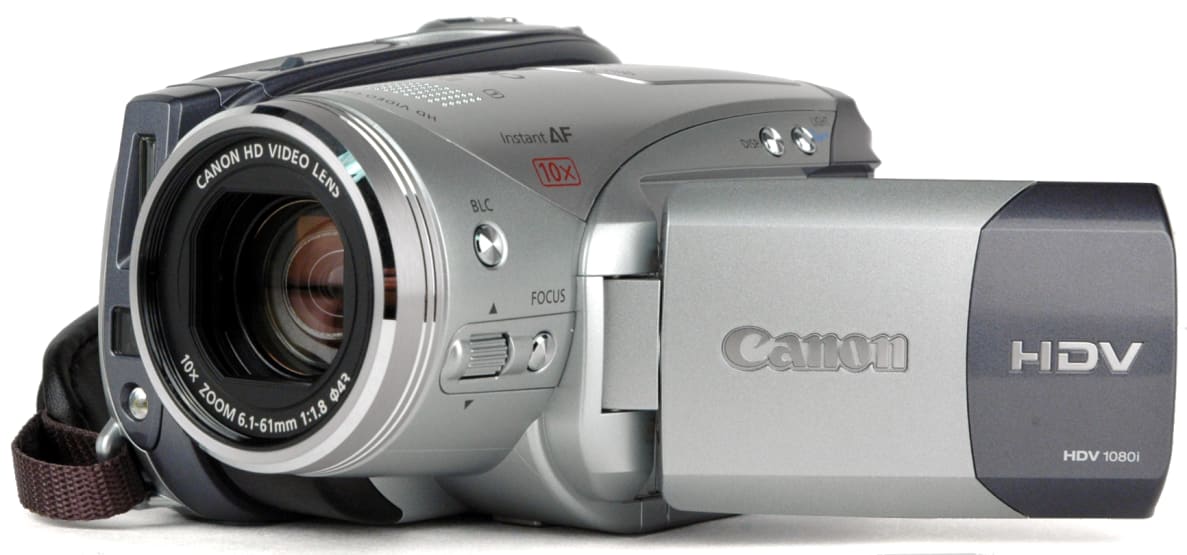Performance
The Canon HV20 comes equipped with some familiar innards: the same 1/2.7" CMOS and Digic DVII processor found in the HV10. Last year, we found the HV10 to have the best bright light video performance of any consumer HD camcorder, but the low light was disappointing. This chip offers a gross pixel count of 2,960,000. In 16:9, this equates to a 2,070,000 effective pixel count. In 4:3, the pixel count is reduced to 1,550,000.
1080i
In bright light, the footage from the HV20 looked as good as the HV10, that is to say… excellent. The most remarkable feature of the video performance is the crispness and clarity. So many consumer HD camcorders of late have held true to resolution expectations, but once you blow them up on a big screen, the noise becomes evident. The HV10 had a distinct lack of apparent noise. Up close, it turns out that the Canon HV20 does not actually lack noise so much as produce a finer grain than the competition. Sony’s HDR-HC7 had great looking color in bright light (certainly more saturated), but the blue channel’s noise is so much more apparent to the eye because the grain is large. The Canon HV20 was also brighter than the HC7 in 1080i auto mode. The Sony clearly showed more in-camera sharpening, which helped bring out borders, but our tests showed it to be only incrementally better in the actual resolution. In bright light, the colors were richer than the HV20; the opposite held true in low light. Full resolution images here.
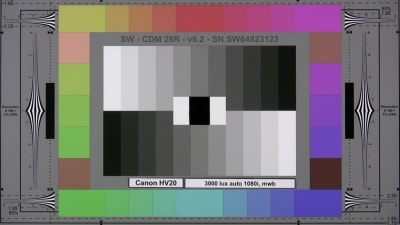
Just for comparison’s sake, we also held the HV20 up against the XH A1 ($3999 MSRP), a price difference of about nearly $3000. Technically, this is the next step up in the Canon HDV line, though we doubt very much that someone would be torn between one or the other. The XH A1’s image was less saturated and more accurate. Pro camcorders like this record the image with peak fidelity, assuming that if you want more saturated colors, you can do that in post. Consumer camcorders make the assumption that you’ll want them more saturated, so they might as well do the work for you. The Canon XH A1 also had far, far less in-camera sharpening. Again, it’s working under the assumption that you want the most accurate image.
24P
More or less the widow-maker feature that makes the HV20 the year’s most alluring HDV consumer camcorder, recording in 24P is simply beautiful. This is true 24 progressive frames per second, not a digital effect. Because the frame rate is slowing down compared to 1080i, we expected some increased sensitivity. The real question was whether that sensitivity would result in increased noise. We’re pleased to say that we did not see a noticeable increase, at least in bright light (3000 lux).
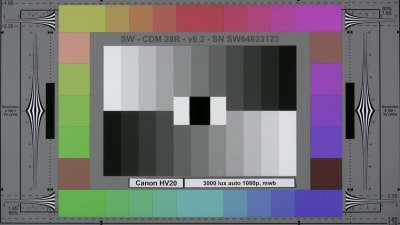
Not everyone wants to shoot in 24P, but you’ll probably want to once you see the HV20’s performance. We must preface, for some readers, that 24P does not look like film. Not ever. Not Ever, does video look like film, at least not without very expensive camera and post production equipment. In other words, it will never happen with this camcorder. What 24P does offer is a different look, particularly to motion. Fortunately, the HV20 managed to avoid some of the staccato motion stutter of older camcorder that try to emulate true 24P. Those accustomed to 60i and 1080i might find the difference in motion rendering unsettling. There is an unquestionable divide between adherents to different camps, based largely on aesthetics. You’ll have to work this part out for yourself. We found that the 24P mode also had the benefit of a producing a great look on finely textured surfaces like fabric. Shooting fast motion, like sports, however, would be better in 1080i. All in all, the 24P mode is reason enough to choose the HV20 over anything else on the market in this price range, because it’s presented as an option. See below for the benefit 24P had on our low light tests.
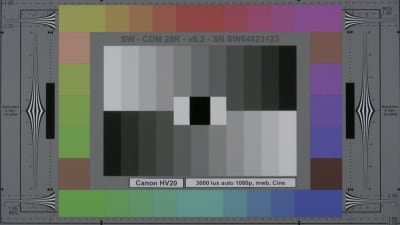
Cinema Mode
The other selling point on the Canon HV20 is the Cinema, or CINE, Mode. Independent of 24P, you can also use this color setting with 1080i or 60i shooting modes. The HV20’s CINE mode corresponds to the XH A1’s Cine V mode (Custom Preset #8). This shifts the gamma curve to respond to a greater dynamic range in the lower end, decreases sharpness, and generally reduces saturation. The camcorder also has options for minor manipulations in sharpness, brightness, color depth, and contrast. These effects are outlined in the Other Manual Controls section later in the review. Full resolution images here.
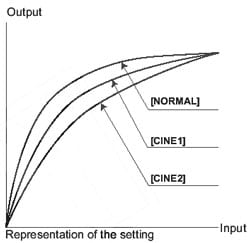
*Taken from the Canon XH A1 manual, this diagram shows the gamma curve
of normal video and CINE 1. There is no CINE 2 setting on the HV20. *
Video Resolution* (18.75)*
To test the resolution of the Canon HV20’s video, we shoot a DSC Labs video resolution CamAlign chart under bright, even light. Resolution is measured in line widths per picture height. In 1080i, the HV20 showed a vertical resolution of 575 lw/ph and a horizontal resolution of 625 lw/ph. In 24P, the camcorder actually improved the vertical resolution, producing less break-up and artifacting in areas of high-density information, boosting the vertical resolution up to 600 lw/ph. The horizontal resolution remained unchanged at 625 lw/ph.
These scores were similar to the Sony HDR-HC7, which produced a slightly higher score 650 lines of vertical resolution and 580 lines of horizontal resolution.
Low Light Performance* (16.6)*
Last year, the Canon HV10’s weak point was low light performance, and kept us from making it a recommended buy. When the HV20 was announced, Canon stated that they had increased the sensitivity, yet retained the same imager and processor as the HV10. At the time, they were unable to state how exactly this had been achieved. The answer is clear to us now: 24P.
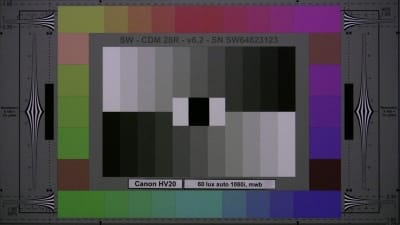
There are differences in the HV10 and HV20’s 1080i image, though. We saw a bump in overall brightness in 1080i, most likely due to an increased gain. This had the effect of making the image noisy, seemingly noisier than the HV10, but overall preferable. We complained bitterly about the dim picture on the HV10. Sacrificing some noise for a brighter, sharper picture was the answer. The image was noisy in both images, but importantly, the look of the noise has changed. Whereas in the HV10, the noise was of a larger grain, with a lot of visible blue noise, the HV20 has a finer grain noise. We like the improvements this year. To the eye, the 1080i, 60 lux image looked similar to the Sony HDR-HC7 in terms of color reproduction, though the HV20 appeared a little richer. Canon clearly edged out Sony in sharpness, and also produced a cleaner image in the dark greys and blacks. Sony’s blacks were too noisy.
In 1080i, the Canon HV20 produced a much better level of sensitivity than the Sony HDR-HC7, achieving 50 IRE at a light level or 7 lux. The HC7 required 17 lux. Sony had a slightly better color error of 11, versus 11.9 from the Canon HV20, according to Imatest imaging software. The HV20 was very similar in noise to the HDR-HC7: 2.14% for Canon versus 2.52% for Sony. This was no surprise, given what we saw by our own eyes. Full resolution images here.
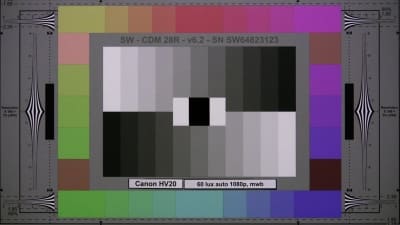
Switching over to the 24P mode, the strength of the Canon HV20 becomes clear. This camcorder is a killer in low light. The sensitivity (ability to produce 50 IRE) dropped all the way down to 3 lux, a fraction of the light required by the Sony HDR-HC7. Not only that, in 24P the color error decreased (8.24) and the noise decreased (1.81%). Because the 24P mode is a regular shooting mode, and not a special effect, we used that performance to tabulate the final score for Low Light Performance. Scores factor in sensitivity, noise, and color accuracy.
Comparing the 1080i images and 24P images side-by-side, the difference to the eye is clear. Any doubts about shooting 24P will wash away. Noise is more visible, to be sure, but the color performance is excellent.
Against the HV20’s 24P mode, the Sony HDR-HC7 could not hold a candle. Canon hands down.
Of course, the HV20 was soundly trounced by the Canon XH A1 (no surprises here). The XH A1 at 60 lux was nearly as bright as in 3000 lux. No consumer camcorder can make that claim.
We remind readers that the scoring rubric has changed for 2007, so the score of the Canon HV20 is not directly comparable to the score of the Canon XH A1.
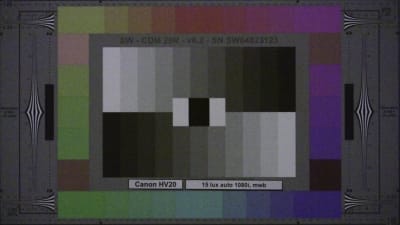
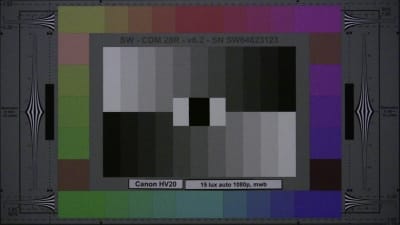
Stabilization* (7.13)*
The Canon HV20 is equipped with the company's Super Range OIS, an optical image stabilization (OIS) system that reduces the effects of camcorder shake on recorded video. OIS systems stabilize the image by physically isolating the lens element from the camcorder body, sometimes using gyroscopes or motors. Canon’s Super Range OIS also employs digital processing to improve stabilization of long focal length shots, and the system works very well. The other more common stabilization method, EIS (electronic image stabilization), reduces vibration through digital processing alone, and reduces video resolution. OIS does not reduce video resolution and is a superior stabilization system.
We tested the HV20's OIS system using our camcorder shake emulator, custom built for Camcorderinfo.com. The shake emulator can be adjusted to produce movements at different intensities and frequencies.
We tested the HV20 at Speed 1, equivalent to the shake produced while holding a camcorder and standing still; and Speed 2, equivalent to the more intense shake of a moving vehicle. The Canon HV20's OIS reduced recorded image shake by approximately 83% at Speed 1, and 36% at Speed 2. Measuring the motion difference between footage shot with OIS off and OIS on derived these calculations.
Wide Angle* (10.0)*
We measure the field of view of camcorders in 16:9 mode. The zoom is set to its widest angle, image stabilization is turned off, and we view the full video frame on an external monitor derive a field of view measurement. The HV20's maximum field of view was 50 degrees.
Format
Compression* (7.0)*
The Canon HV20 uses HDV compression, a very efficient MPEG-2 codec with a fixed data rate of 25Mbps, identical to the data rate of standard definition DV compression. HDV excels in capturing stunningly high-resolution video, but it is inferior to DV in terms of rendering motion realistically, due to its dependence on interframe compression. This means that at 1080i, only one in fifteen frames is a full-frame picture, while the intervening frames are compressed in relation to each full I frame. Interframe compression is much more efficient than intraframe compression, and allows HDV to squeeze a full 1920 x 1080 picture into a 25Mbps stream, recordable to inexpensive MiniDV tapes. DV uses intraframe compression, so each frame is a fully independent picture, allowing much better motion capture. DV also uses a superior 4:1:1 color space while HDV encodes via a truncated 4:2:0 color space.
The inherent weaknesses of HDV have led many networks to deem the format sub-standard for broadcast, but it is still the best high definition format available on the consumer camcorder market. Most consumers find the stunning resolution of HDV trumps the superior motion handling of DV. A professionally lit HDV interview (or any HDV shot without too much detail or motion) can look nearly as good as footage shot in a professional HD format on a $20,000 camera. AVCHD, a new HD format that uses H.264 compression was introduced in 2006 and compresses video even more aggressively than HDV. Our tests of Canon's UX1 and SR1 last fall show that while AVCHD video is very sharp, it suffers from grain and artifacts much more than HDV compression. The wildcard in the consumer high definition arena is a new MPEG-2 format developed by JVC, the MPEG Transfer Stream codec, which appears for the first time in the Everio HD7. MPEG Transport Stream compresses video at up to 30Mbps, and may rival or even outclass HDV compression.
Media* (6.0)*
Like other HDV camcorders, the Canon HV20 records to MiniDV cassettes, the same inexpensive and widely available format used by standard definition DV camcorders. MiniDV cassettes have a run time of 60 minutes in SP mode, but can hold up to 90 minutes of more compressed LP video. Unlike the DVD, memory card, and HDD formats, MiniDV tapes are linear media so moving clips to a PC from tape is a real-time process. For anyone serious about the quality of his or her video, HDV recorded to MiniDV cassette remains the best consumer HD option available. To date, consumer non-linear video formats do not support the highest-quality video compression codices for high definition (HDV) and standard definition (DV).
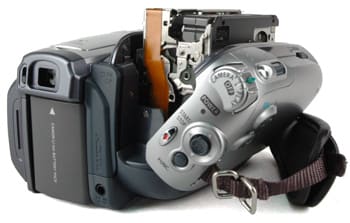
Editing* (7.0)*
The Canon HV20 records both HDV and standard definition DV video to MiniDV tapes, and both formats are now broadly supported by consumer and professional NLEs (non-linear editors) like Apple iMovie and Final Cut Pro, Avid Liquid and DV Express Pro, and Adobe Premiere. Transferring footage to a PC or Mac for editing is done via the included IEEE 1394 (otherwise known as FireWire, and branded as 'i.LINK' by Sony) cable, so your PC will need an appropriate adapter. All Macs are IEEE 1394 compatible.
Due to its higher compression rate, working with HDV footage is much more processor-intensive than DV, but any newer computer with at least 512MB of installed RAM (and preferably 1GB) running an HDV-compatible NLE should be able to handle 1080i footage.
Auto / Manual Controls
Picture & Manual Control* (0.0)*
Automatic Control (8.5)
The Canon HV20 is a camcorder that boasts stellar to excellent performance in standard HDV (1080i) Auto mode, and it’s easy to move from Program Recording mode to Auto using the two-position Mode switch on the right side of the camcorder, near the Power/Camera/Playback dial. In auto mode, exposure and focus reaction time are virtually identical to Sony’s HC7. The two camcorders also traverse their zoom range in exactly the same amount of time. White balance seems to make its auto adjustments similarly as well, though differences arise when controlling these camcorders manually (more on that below, in the Manual Control sections). All in all, the HV20 is an excellent point and shoot camcorder, and the fact that it goes toe to toe with the HC7 is impressive because Sony’s Easy Mode generally governs automatic image adjustments with slightly more refinement than Auto modes from competing manufacturers.
When the camcorder is switched to 24P, there is a slight drop in auto adjustment reaction time. This is a change that we’ve seen across the board in camcorders that support both interlaced and progressive recording, and stems from the slower frame rate in 24P. With fewer frames per second to assess, the image processor simply needs more time to make its adjustments. We noticed that the performance drop was especially noticeable in low light focusing situations in 24P versus 60i. The combination of low light and progressive frames was particularly challenging for the HV20, and response time slowed over 60i. In another scenario, we placed the HV20 and HC7 side by side to see how well they focused on a nearby object in front of a brighter, but still dim, background. The difference between the two camcorder’s auto focus systems was highlighted in this situation, with the Canon snapping into focus on the nearby object (about two feet away) and the Sony fixing focus on the brighter background. Clearly the two camcorders have differently optimized auto focus systems, but the Canon got this particular shot while the Sony failed. Of course, either camcorder could be thrown into a manual record mode, but working strictly with auto controls, the Canon’s focus performed better.
The Canon’s auto white balance was more accurate than most consumer camcorders we’ve seen. Typically, there is a notable if slight difference between auto white balance and the manual white balance setting under identical lighting conditions. On the HV20, the two settings yielded remarkably similar results under controlled studio lighting and in consistent outdoor lighting. In more challenging recording situations such as low light and low contrast, the Canon still ran into trouble in auto mode as do all camcorders. Focus continued to perform amazingly well, and the HV20 was able to lock in a crisp focus in lower light than any consumer camcorder we’ve seen.
All things considered, the HV20 was singularly adept in auto mode. Its white balance settings were unusually accurate in friendly lighting, and auto focus was the best we’ve seen on a consumer camcorder. Auto mode on the HV20 can be regarded as a viable tool by experienced shooter, and will deliver excellent results for point-and-shooters.
Overall Manual Control (7.75)
The Canon HV20 offers a very good manual control suite that matches the other top consumer HDV camcorder on the market, on balance. However like the Sony HDR-HC7, this Canon is good but definitely not what it could have been with a little more vision on the part of it’s developers. We hit the HC7’s primary manual controller hard. The Sony has a multi-function Cam Control dial that can be used to adjust focus, exposure, white balance shift, AE shift, and shutter speed. On paper, a multifunction controller that keeps a suite of key manual controls instantly accessible seems great – but the dial is too small to use with precision, and toggling from one Cam Control image setting to another is time consuming. The HDR-SD1, Sony’s first HDD-based AVCHD camcorder had a much better Cam Control ring that was much better than the tiny HC7 dial as a manual control interface. Panasonic’s HDC-SD1 offers another good manual controller in the form of the rear-mounted joystick, and adds independent gain control to its quiver, a control the Canon and Sony lack. So how does the Canon HV20’s much-anticipated manual image control suite stack up against its rivals? On balance, about the same.
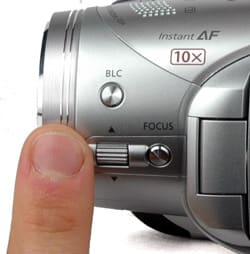
The HV20 allows independent control over just about everything except for gain, in its Recording Program modes. Pressing the function button, and selecting the icon at the top left corner of the screen allows you to choose from Program AE, Shutter Priority, Aperture Priority, or Cine modes. In Program AE, designated by the P icon, the camcorder adjusted shutter speed and aperture automatically. In all these modes, it is possible to fine tune exposure by pressing the joystick once, to bring up the Set display in the lower right corner of the LCD. Manual exposure (in EV steps) is the first option in the Set display, and tapping up on the joystick engages control over exposure, while tapping down moves through the Set menu pages (Mic levels, and End Search). The HV20 adds two modes found on the company’s prosumer camcorders, like the XL 2S and XH A1: In Tv, or Shutter Priority, you can set shutter speed manually while the camcorder adjusts aperture. In Av, or Aperture Priority mode, you can set the aperture manually while the camcorder adjusts shutter speed. Thankfully, in Av mode, the shutter speed will not drop below 1/60 unless Color Slow Shutter is enabled.
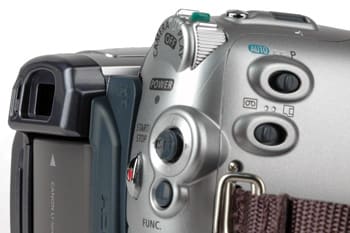
A closer look at the joystick
The Sony HDR-HC7 and Panasonic HDC-SD1 both allow for better independent control over aperture and shutter speed than the Canon HV20, however the Canon manual control interface is arguably at least as fast as the Panasonic, thanks to both joystick controller. The focus dial is a disappointment, just as the Cam Control dial on the HC7 was – but it offers even less functionality, as it is only a focal control. On the plus side, the Canon keeps exposure, audio level control, and End Search a few taps away. These are functions that you’ll be likely to access frequently, and Canon has smartly kept them close at hand. Canon also adds a Focus Assist option that both magnifies the image and adds peaking. Even though the dial is small, this assist function makes finding focus an easier process than on the HC7. In the end, the Canon is a good camcorder when it comes to manual controls, but like its competitors, it’s flawed. The Sony provides an even higher level of independent manual image control…but the Canon adds a very useful Focus Assist feature to the mix, and keeps exposure and audio levels close at hand. Despite the Sony Cam Control dial that beats out the Canon focus-only dial, Canon’s manual controls remain as easy to access and use as those on the Sony, and Canon serves up some juicy assists that will make this a better camcorder for getting a shot before the moment has passed.
Zoom (5.0)

The primary zoom control on the Canon HV20 has a general design that resembles the excellent rocker found on this year’s Canon ZR Series camcorders, as well as on most Sonys – but this is one control where Canon falls shot. Whereas most rocking lever type zooms extend several millimeters above the top of the camcorder body to improve handling, the HV20’s winks through a thin little slot. The point of contact consists of a thin plastic ridge, while most similar zooms offer a larger surface area that allows for better leverage and fingertip control over zoom speed. This zoom controller is not the worst we’ve seen, but it is disappointing on a $1000 plus camcorder, and a rather puzzling flaw. The action of the HV20 zoom motor is nearly identical to the Sony HDR-HC7, but the rocker itself is mediocre. The Canon also includes three fixed speed options in the Camera Setup sub-menu. Speed 3 is moves at a constant medium speed, speed 2 is slow and speed 3 is a slow crawl, which proves very useful for fine framing adjustments. In video recording mode, the VCR buttons along the base of the LCD frame offer a secondary zoom control, and will move the zoom at the current fixed speed setting (speeds 1 to 3) or if the speed is set to variable, at a fixed medium speed (speed 3).
The Canon also includes a digital zoom feature that can be disabled, capped at 40x, or set to a maximum of 200x. As always, the digital zoom on this camcorder should be used with caution because there is a steep drop-off in image quality when the optical/digital zoom boundary is crossed. Digital zooms work by magnifying the image information available at a camcorder’s top optical zoom power, so rather than a 40x image, you’ll be looking at a 4x digital blowup of a 10x image. When the 40x digital zoom is engaged, the normally white zoom indicator bar at the top left of the LCD screen adds a light blue segment to the right of the white area, that corresponds to 10x-40x. When the digital zoom is set to its 200x maximum, a darker blue segment is added to the right of the light blue one, indicating 40x-200x territory. The different colored segments allow you to be aware of when you cross the optical/digital threshold, and when you cross from into 40x-plus territory, but the Canon ZR camcorders feature another quality control feature. At the optical/digital boundary, those camcorders will pause for a second. That "speed bump" gets in the way of a smooth optical to digital transition, but does help to ensure that you’re never magnifying pixels when you don’t want to.
Zoom Power Ratio (10.0)
Camcorders like the Canon HV20 and the Sony HDR-HC7 have massive imagers compared to most consumer camcorders. While large sensors like the HV20’s 1/2.7" CMOS produce dazzlingly sharp video, they lower the optical zoom power of high-end HDV camcorders into the pedestrian realm. Canon’s HV20 and the consumer HD camcorders from Sony and Panasonic all have optical zooms that top out 10x, placing them at the low end of the consumer camcorder market. A camcorder’s dimensions and the focal length of the lens limit optical zoom magnification. 10x is modest, but the performance dividends offered by the large imager make it a worthwhile trade-off.
The HV20 includes a digital zoom option that can be set to 20x, or disabled. When the digital zoom is enabled, the horizontal zoom bar on the LCD display is divided into two sections to indicate the boundary between optical and digital zoom territory. As always, digital zoom should be used judiciously because it literally blows up the available pixels in the image to create the illusion of greater magnification. On the positive side, this digital zoom maxes out at a relatively low 20x, or twice the optical zoom power. This means that the pixels will only be enlarged by a factor of two rather than the outlandish digital zooms on many consumer camcorders that range up to and beyond 1000x.
Focus (6,5)
The Canon HV20 is well equipped with manual focus options, including an excellent Focus Assist feature that makes this arguably the best consumer HD camcorder on the market for locking in an accurate manual focus. When operating in any Recording Program, the small Focus button allows you to toggle between auto and manual focus. The dial just forward of the Focus button is used to adjust focus. As a controller, this dial is very similar in form and function to the Cam Control dial found on the HC7 (though that dial adds control over several other image settings in addition to focus). The Canon dial in and of itself is a good controller, but lacks the finesse of a real ring controller that allows for larger hand movements when making focal adjustments.
What makes this camcorder stand out is the Focus Assist feature, which is engaged by pressing the VCR Stop button on the lower right corner of the LCD frame while focusing manually. Focus Assist combines peaking with a 2x magnification of the displayed image, which does much to compensate for the small size of the LCD screen. In the realm of consumer camcorders, the 2.7" LCD on the HV20 is actually average, but relative to the resolution of an HD frame, it is tiny. Focusing a high resolution HD image accurately using any on-camera display is notoriously difficult, and cost of a slightly soft HD image is steep, since soft focus on a 40" screen is glaringly apparent. Rather than equip the HV20 with a larger LCD (some Sonys have screens that measure up to 3.5" diagonally), Canon has added a quick access assist that allows you to focus manually with confidence.
The camcorder’s Instant AF feature (and auto focus in general) deserves mention here. It works very well, and responds more quickly, more accurately, and in more challenging recording situations than virtually any camcorder we’ve seen since the Canon HV10. Instant AF works well enough for us to give it our endorsement for a wider range of recording situations that most camcorders can accommodate, and is a viable option for run and gun shooting. We would not say the same about nearly every other consumer camcorder’s auto focus we’ve tested, so Canon deserves kudos for delivering an exceptional auto focus and a manual focus with an assist function that makes it easy to focus an HD image quickly and accurately.
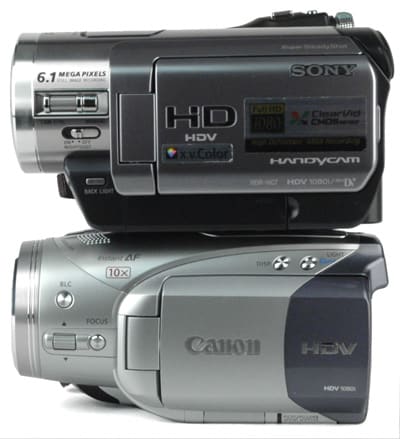
*The remarkably similar-looking dial on the Canon HV20 and Sony HDR-HC7
proved to handle slightly differently. Overall, we preferred the Canon. *
Exposure & Aperture (7.1)
The Canon HV20 allows you to control exposure in EV (exposure value) steps in any Recording Program mode by pressing the joystick, and selecting the Exposure option. Keeping this adjustment (along with Mic levels and End Search) immediately available without entering the menu is one of the very practical videographer-centric features that we love about this camcorder. Yes, we’d prefer that Canon some additional options like shutter speed and white balance equally accessible, but exposure is something that is adjusted as often as focus and users are well-served by fast joystick access.
What the HV20 does not offer (that the Sony HDR-HC7 and all Panasonics do) is fully independent control over all the parameters that govern the brightness of the image. If independent control over aperture and shutter speed is something you demand, you should think hard before purchasing this camcorder and make sure you have a thorough understanding of what it can do and what it cannot. For most purposes, the HV20’s exposure adjustments should be more than adequate. In the P, Cine, and Special Scene Recording Programs, control over exposure is limited to modifying exposure in EV steps on a scale from -11 to +11. When the exposure control is engaged, a horizontal blue scale appears near the top left corner of the LCD screen, and pressing the joystick left or right modifies exposure in whole number increments.
Two additional Recording Programs allow for either shutter speed adjustment or aperture adjustment. In Tv (Shutter Priority) mode, shutter speed can be set while the camcorder adjusts aperture automatically. In Av (Aperture Priority) mode, the iris can be adjusted in f-stops by pressing up or down on the joystick. The current f-stop setting is displayed at the upper left corner of the LCD, and the available settings are f/1.8, f/2.0, f/2.4, f/2.8, f/3.4, f/4.0, f/4.8, f/5.6, f/6.7, and f/8.0. One last feature is worth mentioning. In the Image Effects sub-menu, under Custom, brightness can be set to -1, +1, or left at the default of 0. This is a rudimentary exposure compensation feature that will raise or lower the brightness of the image slightly over the HV20’s default settings.
Shutter Speed (7.1)
In Tv (Shutter Priority) mode, the HV20 offers a wide range of manual shutter speed options, depending on whether you are recording in standard 1080i, 24P, or memory mode. In 1080i, the shutter speeds available are: 1/8, 1/15, 1/30 1/60, 1/100, 1/250/1/500, 1/1000, 1/2000; in 24P: 1/6, 1/12, 1/24, 1/48, 1/100, 1/250/1/500, 1/1000, 1/2000; and in memory mode: 1/2, 1/4, 1/8, 1/15, 1/30, 1/60, 1/100, 1/250, 1/500. This range is narrower than the options offered by the HDR-HC7, which goes down to 1/4 and as high as 1/10,000, but it should be more than adequate for most shooting situations. In addition, the 1/6 shutter speed setting in 24P offers more light gathering power than the HC7, and perhaps any comparably priced consumer camcorder, thanks the HV20’s stellar low light performance. With the shutter speed set to 1/6, the camcorder captures a surprisingly good (if blurred) image, with decent saturation and less grain than most camcorders in low light.
White Balance (7.5)
Canon’s HV20 includes a good selection of white balance presets, including Auto, Daylight, Shade, Cloudy, Tungsten, Fluorescent, Fluorescent H, and Manual. This adds up to more presets than you’ll find on competing camcorders, which often only provide daylight, and indoor presets. The white balance sub-menu is thankfully just below the Recording Program option on the left side of the LCD screen, and the Manual white balance icon is at the far right end of the list of white balance options. Once you’ve selected the manual white balance option, pressing the center of the joystick locks in the setting; when the icon stops flashing, white balance is set. We noticed that manual white balance on the HC7 consistently locked in faster than on the HV20 (one second versus a few seconds) though they both yielded good results.
Gain (0.0)
The HV20, like most consumer camcorders, does not offer independent manual control over gain. Panasonics, including the HDC-SD1 are the notable exception to the rule, offering gain control from 0 to 18dB. This is also one of the many distinctions between the Canon HV20 and the Canon XH A1, which has a robust gain control outfitting.
*Other Manual Controls (5.5)
**Custom Image Effects - *Image Effects are accessed by pressing the function button, and navigating to the Image Effects sub-menu mid-way down the left side of the LCD screen. The options available include: Image Effect Off (default), Vivid (boosts contrast and color saturation), Neutral (lowers contrast and color saturation), Low Sharpening (lowers in-camera sharpening), Soft Skin Detail (softens edges in "skin toned" areas), and Custom. The Custom setting allows you to adjust several parameters on a three-point -1, 0, +1 scale. These parameters are: Color Depth, Brightness, Contrast, and Sharpness.
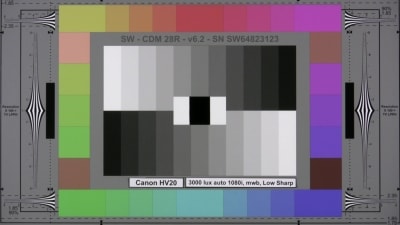
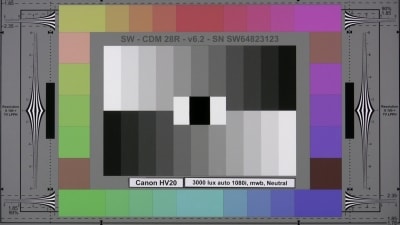
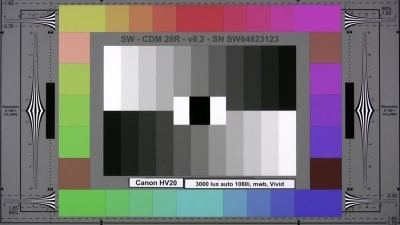
*Zebra Stripping - *Zebra Striping is an assist function that can help with setting exposure correctly found in the Display Setup sub-menu within the Assist Function option, and can be set to 70 IRE or 100 IRE. When the zebra option is engaged, diagonal "zebra stripes" are superimposed over those areas in the frame that surpass the current zebra setting. This is a tool that can be invaluable for setting exposure manually, and is generally only seen on high-end consumer camcorders though it’s standard-issue on prosumer models.
*Peaking - *Peaking is a focus assist feature also found under Menu > Display Setup > Assist Function. When peaking is enabled, the edges of objects in the frame are sharpened to make it easier to dial in sharp focus manually. Peaking also makes an appearance, bundled with display magnification, when the Focus Assist button is pressed. Unlike Focus Assist, which appears momentarily, and then disappears after use, Peaking remains in effect until it is disabled in the Display Setup sub-menu.
*Manual Audio Level Control - *Manual audio level control is closer at hand on the HV20 than most consumer camcorders that offer this feature – buried in the menu. On the HV20, pressing the joystick during any Recording Program mode brings up the Set menu, and pressing down cycles through the options, labeled EXP (exposure), MIC (audio levels), and End Search. When you’ve reached MIC, pressing up on the joystick engages manual level control, and pressing left or right raises or lowers the audio recording level. Mic levels are displayed at the lower right corner of the screen, with markers at -40dB, -12dB, and 0dB.
*Microphone Attenuator - *The Mic Attenuator applies a digital pad to the audio levels, and is useful for recording sound in dynamic or very loud environments without clipping. Canon does not list the specifications for this control, but it appears to apply about a 10dB pad to audio levels.
*Headphone Volume - *Headphone volume can be adjusted using the joystick in the Play/Out sub-menu. This adjustment is rare on consumer camcorders, and a very welcome addition to the HV20’s audio suite.
*Markers - *The Canon HV20 offers two marker display options to assist with shot framing, and each option can be displayed in white or grey. The Level marker option superimposes a horizontal line across the vertical mid-point of the screen, with a small vertical mark at the center; the Grid option superimposes a nine-box grid on the screen. Markers are not recorded, and their default setting is off.
Still Features
Still Features* (9.25)*
Canon goes to great lengths to link their camcorders to the company’s deserved excellence in still photography. Like most Canons, the HV20 does feature some impressive still photo options, as well as decent still resolution. Yet no camcorder, including Canon’s top consumer HDV cam, are true hybrid standouts. For the foreseeable future, you are still be better off with a $200 digital still camera than a single "hybrid" but the HV20 does well for what it is. Still photo resolution can be set to 2048 x 1536 (4:3), 1920 x 1080 (16:9), 1440 x 1080 (4:3), or 640 x 480 (4:3) in memory mode, and each of these can be set to a quality of Normal, Fine, and Superfine. In addition, stills can be captured during playback or recording at the current video resolution. During 16:9 DV playback or recording, stills are captured at 848 x 480.
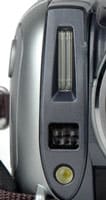
To capture stills at the highest available resolution, you’ll first need to move the recording mode switch from "tape" to "card." Photos are saved to Mini SD cards, which load in the hatch-protected slot in the LCD cavity. A brief note here: many camcorders place their card slots in the LCD cavity without a slot cover of any kind, and that design does make card release more convenient than on the HV20. The slot’s location near the base of the cavity and adjacent to the LCD screen also makes access to the card tricky, especially when the camcorder is tripod-mounted. It’s not a killer in terms of usability, but it could be better.
As in video mode, there are two menus: Function and main. The Function menu contains options for scene modes, white balance, image effects, video light on/off, digital effects, MPEG-2 (low quality) video recording, and still resolution and quality. All the options in these items are the same as in video mode.
The main menu, or administrative menu, has some of the more interesting and useful features, and those that should have been included in the Function menu. Shutter speed control is here, which can be set to Auto, 1/60, 1/100, and 1/250. The auto focus method is also here, which has options for Artificial Intelligent Auto Focus (AiAF), Center weighted, and auto focus off. Unlike in Canon’s still cameras, the AiAF cannot be set to 9-point, 5-point, and 3-point. The detection is completely automatic, looking for the areas with clearest contrast, then automatically honing in on them, and snapping the picture.
The HV20 also allows you to record stills while in video mode, even while simultaneously recording video to the tape. In this mode, the still resolution maxes out at a meager 640 x 480.
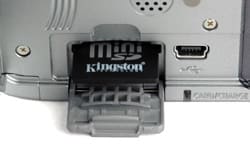
Still Performance* (6.1)*
The Canon HV20’s still photos were tested by shooting a Gretag McBeth Color Checker chart and running those stills through Imatest imaging software. We found the best possible image to be produced by reducing the exposure compensation scale to -1. This scale does not indicate the exact increment, but reading the EXIF data, it appears to be a reduction of -0.25EV. At this setting, the color error was 9.77, with 1.3% noise. The image was oversaturated by 19.4%. Noise actually decreased by leaving the exposure compensation untouched, but the color error increased by a larger margin.
All of the scores indicate a higher color error than is normal in a point-and-shoot camera. Most of the spectrum remained very accurate, but the blue channel shifted very far into oversaturation, pushing the mean color error. Manufacturers will often bump up the blues to make the sky look better in photos. However, you’ll often see an accompanying boost in the skin tone range, which we did not see here to anywhere near the same degree.
Still Resolution* (26.6)*
The Canon HV20’s stills were tested for their resolution by shooting an Applied Image ISO 12233 resolution chart and running those stills through Imatest imaging software. Resolution is measured in line widths per picture height (lw/ph). The camcorder proved to have a strong tendency towards underexposing the blacks, even in bright, even illumination. This can produce a "clipping" error in Imatest. In order to combat the problem, we bumped the exposure compensation up as far as +1.25EV. This managed to get the clipping percentage down to 0.9%. At this setting, the camcorder produced a horizontal resolution of 1412 lw/ph, and a vertical resolution of 1318 lw/ph. The image was oversharpened by a relatively small degree at this setting, only 2.72%.
Handling and Use
Ease of Use* (7.75)*
This year’s crop of HD Canon HV20, the Sony HDR-HC7, and the Panasonic HDC-SD1 combine potent manual image controls with consumer-oriented ease of use. The two top HDV camcorders – the HV20 and HC7 – are both quite approachable, and very similar in terms of outward appearance, but in terms of physical handling, the Sony has an edge. The Canon is a shade smaller, giving the Sony a tad more weight and stability (but a shade less portability). More importantly, the Sony’s key right hand controls – the zoom rocker, Mode Dial, and Record/Start/Stop button are better positioned. In addition the Sony’s hand strap is better padded and more comfortable. The Canon doesn’t feel quite right in your hand, and I found that operating the zoom rocker and the joystick required an awkward grip that required me to split the difference between optimal shooting and optimal control navigation. Another weak point on the Canon is the viewfinder, which has a sharp image, but is too small for comfort, and does not extend out from the body.
In other ways, working with the HV20 is a breeze. Auto mode is comparable to the better other better consumer camcorders, and the auto focus with Canon’s Instant AF is fast and generally accurate. The Recording Program modes also can make your life easier once you learn the quirks of each mode, and options like P (AE), Av, Tv, and Cine offer rapidly deployable manual control modes. The HV20 is an easy camcorder to shoot with, and the menu design, manual control implementation, and feature set has been designed to help you get your shot. Unfortunately, Canon dropped the ball when it came to the ergonomics of handling this camcorder.
Handling* (5.5)*
I mentioned some of the strengths and weaknesses of handling the HV20 in the Ease of Use section above, so here I’ll expand on how you can expect the camcorder to handle on an actual shoot. In a nutshell, the HV20 has been built around the needs of the videographers, whether they’re a point-and-shooter or a veteran. Despite some major compromises in the physical handling area, Canon has done an admirable job of outfitting the camcorder with a limited but well selected set of features.
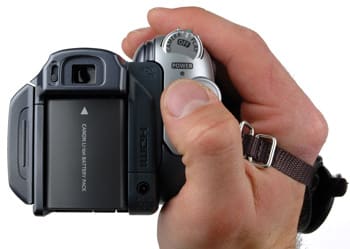
Focus is a particular strong point of this camcorder, and that’s vital for shooting HD video where the any focus errors are magnified. The focus dial is just OK, on par with the Cam Control dial on Sony’s HDR-HC7. The Focus Assist and Peaking options on the HV20, however, make it the best consumer camcorder currently available for focusing manually. With the help of Focus Assist, conveniently engaged by pressing a button on the LCD frame, I found the HV20 to be the first non-prosumer HD camcorder that allowed me to adjust focus manually with confidence. Instant AF, Canon’s proprietary auto focus is also excellent. When we connected the HV20 to our HD monitor, Instant AF consistently focused quickly and crisply in low-contrast lighting that left every other camcorder’s auto focus breathing. Instant AF is one of those rare proprietary technologies that seem to be legit.
Another great inclusion on the HV20 is fast access to three key controls without entering the menu: exposure, audio levels, and end search. All three controls are frequently called upon during a shoot, and in any Recording Program mode, they are engaged by pressing in on the joystick. Zebras that can be set to 70 or 100 IRE are a valuable aid for monitoring exposure, and onscreen marker displays can be used to assist with shot framing. Making manual image adjustments is easy with the HV20 thanks to assists and control placements mentioned above, but also due to the manner in which Canon has limited manual control options. Although the lack of fully independent iris and shutter speed control may be liability in some shooting situations, Canon provides the Recording Programs that you are most likely to use on a day to day basis: Program AE, Shutter Priority (Tv), and Aperture Priority (Av) modes, as well as a solid selection of Special Scene modes. In combination with 24P, these modes offer enough control to make this camcorder a real option for professional video work on the cheap.
In weighing the benefits of Canon’s feature set against others, including the HC7 and SD1 that offer a greater range of independent controls, it is important to consider how those options are implemented on those camcorders, and thus how useful they would be on a shoot. It’s difficult to implement a robust set of manual controls on a compact camcorder like the HV20 without burying some options in the menu, or rolling them into a multifunction controller like the Cam Control dial on the HC7 or joystick on the SD1. Rather than throw in everything but the kitchen sink, Canon has supplied the HV20 with the essentials, and included some very thoughtful features and attributes that I found truly helped me to get a shot that would have been more painful on the Sony or Panasonic. For run and gun or field production, the HV20 handles like a stripped-down but very capable tool.
In the hand, the HV20 is less appealing. The Sony HDR-HC7 feels more solid, control placement is better, and the hand strap is much more comfortable. The Sony offers a stronger overall manual control suite, but many shooters will find Canon’s Focus Assist, and fast access to exposure and audio level controls a more valuable asset. If you’re thinking about buying either of these camcorders, think about how each model would serve your shooting style, and spend some quality time with each one at your favorite camcorder vendor.
Menu* (7.0)*
The Canon HV20 menu epitomizes refined user interface design, and it offers some real speed advantages over other camcorder menus. Part of the advantage stems from what Canon has kept out of the menu. While shooting in any Recording Program mode, both focus and exposure are quickly accessible while the Sony requires toggling the Cam Control dial from one setting to another. In either Tv or Av mode, shutter speed and iris respectively are also one-touch adjustable, by tapping up or down on the joystick. White balance is located at the top level of the menu, as are Program Recording modes and Image Effects, so changing any of these settings can be done in a matter of seconds versus tens of seconds on the HC7. Panasonic’s joystick-based interface is equally quick, but less intuitive than Canon’s, which displays many menu options in an L-shaped list, running down the left side of the screen and along its base upon pressing the Function button.
At the lower left corner of the screen is the Function Menu icon, and selecting this option brings up a screen listing the following submenus: Camera Setup (Auto Slow Shutter, AF Mode, Digital Zoom, Zoom Speed, Image Stabilization and Self Timer); Rec/In Setup (HD Standard, DV Rec Mode, DV Audio, Wind Screen, Mic Att, AV-DV, and File Nos.); Card Operations (Print Ord.All Erase, Trans.Ord.All Erase, Erase All Images, and Initialize); Play/Out Setup (Playback Std., TV Type, Output Ch, Audio Out, Mix Balance, AV/Phones, Phones Vol., Comp.Out, and DV Output); Display Setup (Brightness, Markers, Assist Func., Audio Level, TV Screen, 6Sec.Date, Data Code, Language, and Demo Mode); System Setup (WL. Remote, Beep, Power Save, and Firmware); and Date/Time Setup (T.Zone/DST, Date/Time, and Date Format). Navigating through these Function Menu options is quick and easy thanks to the joystick controller allowing you to move in the four cardinal directions. Pressing in on the center of the joystick selects a given menu option.
Portability* (5.5)*
The HV20 measures 88 x 80 x 138mm (3.5" x 3.2" x 5.4") and weighs in at 535g (1.2 lbs.) without lens and battery pack. This is no pocket-sized HV10, but it will give you 24P in the palm of your hand. Since the HV20’s viewfinder is immobile and shorter than a sleuth’s snub-nosed pistol, it will remain out of harm’s way, as opposed to a retractable viewfinder. The automatic lens cover will aid those who are cursed with flighty memory, but you still have to remember to turn the camcorder off in order for it to close. The LCD screen is cheap, so make sure it is closed at all times during transport.
You won’t be able to fit the HV20 into a pocket comfortably, but a small camcorder bag will do the trick. It won’t weigh you down throughout the day, and the necessities (power adapter, cables, extra tapes) will fit snugly in the bag’s compartments. We recommend a backup battery for the HV20, seeing as how you’ll only get about 40 minutes of recording time off of a full charge. In fact, go for two. You can find them relatively cheap online, and you’ll salvage a good chunk of your short film budget.
LCD and Viewfinder* (6.0)*
Like the HC7, the HV20 has a 2.7" wide 16:9 LCD screen with a resolution of approximately 211,000 pixels. The screen extends to a 90-degree angle in relation to the body and can be rotated vertically 270 degrees. With both camcorders in full auto mode, the HV20’s LCD image is brighter than the HC7’s and has more fine detail, but displays more noise. In addition, the HC7 retains its picture when viewing the LCD at a sharp angle, whereas the HV20’s LCD morphs into a sea of solarization, given the slightest turn.
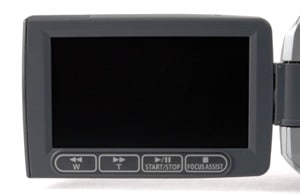
Now on to the viewfinder, or lack thereof. As mentioned earlier in the tour, Canon is really slacking here. The 0.27" inch wide 123,000 resolution hard plastic box does not extend, does not have a rubberized eyecup, and is way to short. This is a sorry excuse for a viewfinder. Good luck adding a bigger battery. To make matters even worse, the tiny dioptric adjuster is embedded in the plastic frame, making it exceedingly frustrating to slide without long nails.
The playback buttons on the LCD panel are flattened like the HC7’s but are easier to handle due to their horizontal layout. The HV20’s LCD hinge is just as weak and breakable as one of Canon’s ZR models, so tread lightly in the handling department. Also, when using the LCD screen, keep in mind that what you are viewing is cropped. Playback on a widescreen 16:9 monitor adds 9mm on each horizontal side and 20mm on each vertical side. At least you’ll be more likely to get the shot you wanted—unless it’s a strict close-up.
**
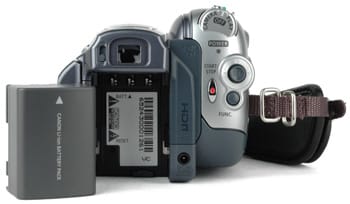
Battery Life*** (11.3)*
The Canon HV20 includes a BP-2L13 battery pack, which slides into an open slot on the back of the camcorder. The open battery slot allows for the use of an optional longer life battery, like the BP-2L14 (good for a reported 155 minutes of continuous HDV recording).
We tested the life of the included BP-2L13 battery pack for continuous HDV recording, in AE mode with the LCD open and set to Normal brightness and OIS set to off. The battery on our HV20 lasted 113 minutes and 22 seconds (1 hour, 53 minutes, and 22 seconds). In comparison, the battery on the Canon HV10 lasted for 71 minutes and the Sony HDR-HC7 lasted for 98 minutes. Canon also lists both continuous, and 'typical' recording time for its batteries. In the case of the BP-2L13, the Continuous time reported is 135 minutes, while the typical recording time is 75 minutes, and takes into account zooms, pauses, and adjustments.
Audio / Playback / Connectivity
Audio* (8.0)*
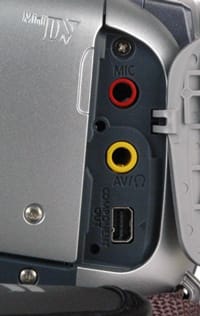
In HDV mode, the HV20 records 16 bit MPEG-1 Layer 2 (MP2) audio, while in DV mode it records 16 or 12 bit PCM audio. This is the HDV audio conundrum: HDV video is four times the resolution of DV, but PCM is superior to MP2. MP3 audio (a compression of PCM) has a higher sound quality than MP2 because it has a greater scope of sub-bands that reduce the bit-rate while pumping up the clarity. MP2 utilizes frequency masking, which compares levels of frequency and drops the channels not discernibly perceptible to the human auditory system. The bottom line is that MP2 sound is like an unkempt, rusty old ’84 Pontiac while PCM sound is like a well-oiled, tuned up ’84 Pontiac. Not a monumental difference, but enough to drive the sound guy up the wall.
Aside from the yin and yang of HDV and DV audio, the HV20 is well equipped with a microphone jack, headphone jack, and Advanced accessory shoe. The combination of the HV20’s microphone jack and accessory shoe will delight low-budget filmmakers who crave stunning 24P HDV video and semi-pro level audio in one compact camcorder. Whereas the HC7 is stuck with Sony’s brand specific AIS that support only four different Sony microphones, the HV20 has a plethora of optional sound devices available, in addition to Canon’s external microphones. Adjusting sound levels on the HV20 is accomplished by pressing the center of the joystick and scrolling down to the mic level bar. It’s a snap. On the HC7, you must wade through Sony’s perilous forest of touch screen menu options before you can even locate the mic levels.
There is a windscreen setting for the HV20’s built-in microphone that, when turned on, works automatically with the camcorder to ensure more balanced sound. There is also a mic attenuator that makes sure the sound doesn’t peak. One noteworthy feature is the headphone volume level meter located in the administrative menu The HV20’s headphone jack is shared with the AV jack, so make sure the camcorder is in headphone mode rather than AV mode, or your ears will be greeted by an explosive swarm of irate queen bees.
Playback* (4.5)*
Tape offers few playback options compared to non-linear formats like DVD and HDD, so don’t expect much here. Thanks to the strip of playback buttons located horizontally at the base of the LCD panel, playing back footage is a snap. The flattened buttons are easier to access than the ones on the HC7 because they are more spread out. From left to right, the buttons include rewind, fast-forward, play/pause, and stop. In record mode, play/pause doubles as the start/stop button, and stop functions as the focus assist button. Playback volume is adjusted by pressing the center of the joystick and shifting right or left to control the volume, which is highly conducive to on-the-fly playback. Classics like end search and playback zoom are available and easy to find in the menu.
In still mode, you can select the quality: super fine, fine, or normal, all at a resolution of 1920x1080. Digital effects are also available, and functions like slow (plays footage in slow motion) and zero set memory (allows you to return to a pre-marked position) are available on the wireless remote. These are pretty basic functions, and Canon has structured the playback on the HV20 to flounder in a pool of simplicity for the benefit of point-and-shooters.
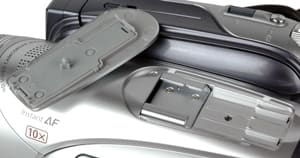
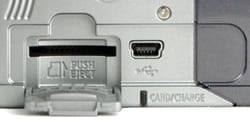
Connectivity* (10.0)
*There are two main port covers on the HV20 and a hinged Mini SD card slot door. The ports located on the right side toward the lens end consist of the microphone jack, AV/headphone jack, and component terminal. A hefty rubberized cover fits well over the panel and is easy to open. The strip connecting the cover is a bit short, though, so you really have to peel it back to reveal the ports. The LANC jack on the HC7 is an added benefit for Sony fans, but will you really need it on a $1200 camcorder? In back, the HDMI and firewire terminals are housed by a flimsy rectangular cover that is a royal pain to close. The strip holding it in place is fairly thin and could snap easily. The round DC jack remains open in the back and is more prone to having a cable yanked out than a rectangular jack. The MiniSD card door is made of the same rubberized material as the port cover on the right side, so it definitely passes the test. It’s also easy to open and close. On top lies the accessory shoe, which is covered by a plastic shield-shaped piece that is not attached to the body. Why did Canon do this? Your guess is as good as ours.
One last feature that deserves mention is the HV20's analog to digital conversion capability. This allows you to pass an analog signal through the camcorder, and then output a converted digital signal via the FireWire terminal to a digital recording device. This is a very handy feature that appears on consumer camcorders from time to time, and enhances the appeal of this cam as a deck.
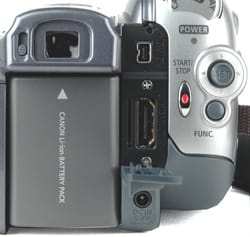
Other Features
What’s in the Box?
The HV20 is an all-star HDV camcorder with oodles of video quality and a price that puts the Sony HDR-HC7 to shame. Therefore, Canon kept the contents of the box fairly light:
-CA-570 Compact Power Adapter (incl. power cord)
-BP-2L13 Battery Pack
-WL-D87 Wireless Controller
-Lithium Button Battery CR2025 for Wireless Controller
-CTC-100/S Component Cable
-STV-250N Stereo Video Cable
-IFC-300PCU USB Cable
-DIGITAL VIDEO SOLUTION DISK Software CD-ROM
An HDV/DV tape would have been nice. Owners of the HV20 will most likely need the added insurance during short film shoots, and the good news is that you can find a BP-2L14 online (the highest capacity battery available for the HV20) between $12-50.
Other Features* (6.0)*
*24P Cinema Mode - *24P Cinema Mode is a 24P recording mode with gamma settings optimized to produce footage with a film-like look. 24P Cinema Mode actually combines two separate camcorder settings: 24P HDV, selected in the Rec/In Setup sub-menu, and Cine Mode, at the top level of the Program Recording mode menu. Both of these settings can be used independently, but Canon has branded them as 24P Cinema Mode when used together. It’s great as a way to instantly get a filmic look, but you’ll record an image with more detail and tonal range in plain old Program AE mode. When you transfer your masterpiece to 35mm film, the technicians will do a better job tweaking the colors in post than the HV20 will ever manage with its camcorder brain.
Video Light – Yes, you get a video light with the HV20. No, it’s not that great. In fact, you’d be better off with a Mag light.
*Backlight Correction – *The backlight correction instantly adjusts the backlight for subjects with a strong light source behind them. This is useful for excessively sunny shots.
*Digital Effects – On the HV20, you get fade-t, wipe, black and white, sepia, and art (which is just a grainy solarization). Not a whole lot to offer here, and all of it can be achieved in post, along with hundreds of other effects. *
*Hot Accessory Shoe – *The HV20’s hot shoe is compatible with a number of boom mics and lights, but we’d recommend a microphone without a doubt because you can externally light a project with ease. As long as you have your own crew.
Comparisons / Conclusion
Comparison
Canon HV10

The HV10 ($999 MSRP) is not just a pocket-sized HV20; it’s a missing some key features that put the HV20 in a separate class. For one, both camcorders have the same 1/27" CMOS sensor and Digic DVII processor, but the gain appears to have been boosted this year in low light, giving it an arguably better picture. The addition of the 24P mode gives the HV20 a huge advantage, more than doubling the sensitivity. That’s not the only major upgrade. The addition of a headphone jack and mic jack add another level of professionalism to the experience. And despite our complaints regarding the HV20’s slim zoom toggle, it’s still better than the HV10’s. For $100 more, you get a lot more with the HV20. It wouldn’t make sense to go for an HV10 unless you absolutely have to impress your friends by randomly pulling a camcorder out of your pocket and passing it around to gain points with everyone.
*Sony HDR-HC7
*

This is the ultimate head-to-head challenge. The Sony HDR-HC7 ($1299 MSRP) had the makings of Camcorder of the Year: 1/2.9" CMOS sensor, microphone and headphone jacks, great handling, and a wealthy palette of manual controls, as well as a LANC jack for tripod or boom operation. But then along came the HV20: rear-mounted joystick, 1/2.7" CMOS sensor, and true 24P. What more could you ask for in a consumer camcorder? Yes, the HV20’s physical handling (that is, the hand held feel of the cam) is a bit on the lame side, and its construction feels cheaper than the HC7. The HC7 adds independent shutter speed and iris control, and a multi-function Cam Control dial. But the Cam Control dial is a mixed bag, and it’s easy to get lost in the jungles of the deep and wide touch screen menu. The HC7 features xvYCC color, but it is not yet supported and is another example of Sony tacking their name to an idea that will not help you on your next shoot.
Navigating the HV20’s menu via the rear-mounted joystick by contrast is as smooth as freshly churned butter. In addition, the HV20 has an accessory shoe that doesn’t require brand-specific compatibility – unless you want your accessories hot, that is – but we’ll take a Sanken CS-1 over Sony’s hot mic any day. You also get an onboard video light (but no commando-style NightShot) and MiniSD card slot as opposed to a Sony-proprietary Memory Stick Pro Duo. More to the point, the HV20 doesn’t offer up quite the level of control that Sony does, but it gives you what you need to get the shot, from Focus Assist to 3 lux low light performance in 24p. The choice should be clearer than a Windexed crystal. The HV20 may be stripped down, but it’s fast as hell, corners on a dime, and sets you back $200 less.
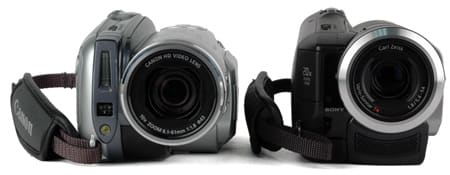
The big showdown, the Canon HV20 versus the Sony HDR-HC7
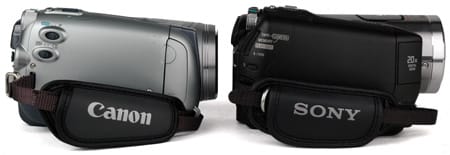
Panasonic HDC-SD1

We’re dealing with two different animals here. The Panasonic HDC-SD1 ($1299 MSRP) is a futuristic-looking AVCHD camcorder that prides itself on its minimalist design and state-of-the-art compression (that is so far impossible to edit). Of course, the SD1 certainly has some impressive features. It packs in 3 CCDs, a 12x optical zoom, and a 5.1 channel Dolby digital built-in microphone. The best part is that it records to SDHC cards. The HV20, although equipped with one large sensor, produces stunning video, has an accessory shoe, and gives you 24P. Since the HV20 is an HDV camcorder, it has a lower compression rate. What we’ve seen so far comparing HDV and AVCHD is noise: HDV is a much cleaner signal. This is a notable quality difference, and could also be what separates the point-and-shooters from the serious filmmakers. The SD1 compresses using the H.264 codec, which shows great potential, but it will take a while to boost its transfer rate. In the meantime, stick with a trusty HDV tape and save $200.
Canon XH A1

You may be asking yourself why we even wasted the space. Well, the Canon XH A1 ($3999 MSRP) is the step-up model to the HV20. Look beyond the fact that the XH A1 is a ridiculously amazing prosumer HDV camcorder with three 1/3" CCDs, XLR terminals, killer low light performance, and more dials, buttons, and sliders than you could ever imagine. So, let’s talk about the video quality. The HV20 performed extremely well in bright light, rivaling the XH A1 with crisp lines and rich, balanced color. The ship sunk when it came to low light performance, but the HV20 displayed the best image a single 1/2.7" CMOS chip could offer against three menacing CCDs. The bottom line is this: if you have the cash, you’re going to pick up an XH A1. If you are on a strict budget, you will find solace in the fact that your independent film will still look great shot with an HV20 in 24P mode. Deployed judiciously, you might even find you can intercut B-roll shot on the HV20 with XH A1 A-roll.
Who It’s For
Point-and-Shooters**
Point-and-shooters will dig the HV20, but will most likely be drawn to the Panasonic HDC-SD1’s sleek design or the HC7’s brand name.
Budget Consumers
Budget consumers will wince at the $1099 price tag, but will soon be comforted by the fact that they are getting a big bang for their buck. One glance at the HC7’s price tag should rebound their eyes back to the HV20 and then over to the register.
Still Photo / Video Camera Hybrid
When it comes to stills, the HC7 has the HV20 beat with a maximum resolution of 2848 x 1602. However, the HV20 has a MiniSD card slot instead of MemoryStick PRO Duo, which runs more expensive for the same capacity cards. The Canon HV20 also had more still features.
Gadget Freaks
The HV20 will intrigue gadget freaks with its HDV format and 24P mode. Other than that, it will take a lot more to impress the geek digging for technological gold.
Manual Control Freaks
Manual controls are right at your thumb on the HV20, and Canon provides enough to get the job done. However, the HC7 has a broader shutter speed range and a few more manual controls than the HV20. In that case, the average manual control freak will most likely seek out an HC7 or a manual control-rich Panasonic HDC-SD1.
Pros / Serious Hobbyists
The video quality and 24P mode is what sets the HV20 apart from all of the other camcorders in its price range. Budget pros might actually consider using the HV20 as a backup camcorder for recording B-roll or stunt cam shots. This is more than can be said for most camcorders in this price range.
Conclusion
The Canon HV20 is that rare camcorder that bursts onto the scene, and sets a new standard in its niche. This is not a perfect camcorder by any means, but it has an intelligently assembled set of features that make it a viable tool for professionals, as well as a stellar point-and-shooter for enthusiasts stepping up to HDV. The camcorder’s physical handling is just mediocre, and most people will find the top-end cams from Sony, Panasonic, and JVC rest more comfortably in their hand. Some basic controls are awkwardly placed, and the zoom rocker feels like a first draft that somehow made it into production. The HV20’s manual control suite is also far from the most robust, or independently adjustable on the market. Unlike Canon, the aforementioned manufacturers offer independent iris and shutter speed control on their HD cams, and Panasonic adds gain control to the mix.
What the Canon has that these other contenders do not is a manual control suite and interface that was designed from the ground up with the shooter in mind. A handful of key image controls are always quickly accessible in any Recording Program mode, including: focus via the dial; exposure, audio levels, End Search, iris (Av mode) and shutter speed (Tv mode) via the joystick; and white balance, Recording Program settings, and Image Effects at the top level of the menu. The HV20 adds Focus Assist at the touch of a button, which combines peaking and magnification, and makes manually focusing an HD image (on a 2.7" screen!) feasible. Once you’ve learned your way around the control interface, you’ll find controlling your image is nearly as fast as on a full-bore prosumer cam. You’re operating in a confined space on the HV20, and options are more limited, but the important features are eminently usable. Sony seems to have missed the forest for the trees by equipping the HC7 with great handling - and a terrific feature set that’s a pain in the neck to actually use. There is room for improvement here, especially in the physical handling department, and if Sony’s next HDV effort takes the needs of the shooter into account, the HV20 may meet its match. JVC’s more expensive - but very intriguing - Everio HD7 is another camcorder to watch closely, and it should make a splash when it hits the US market. But the HV20 is the camcorder of the moment. It works the way a DP thinks more than any other consumer today, and delivers video performance that belies it’s diminutive $1099 MSRP.
Specs and Ratings
{{manufacturer_specs_table}}{{raw_scores_table}}
Meet the tester

John Neely
Editor
John Neely is a valued contributor to the Reviewed.com family of sites.
Checking our work.
Our team is here for one purpose: to help you buy the best stuff and love what you own. Our writers, editors, and lab technicians obsess over the products we cover to make sure you're confident and satisfied. Have a different opinion about something we recommend? Email us and we'll compare notes.
Shoot us an email
